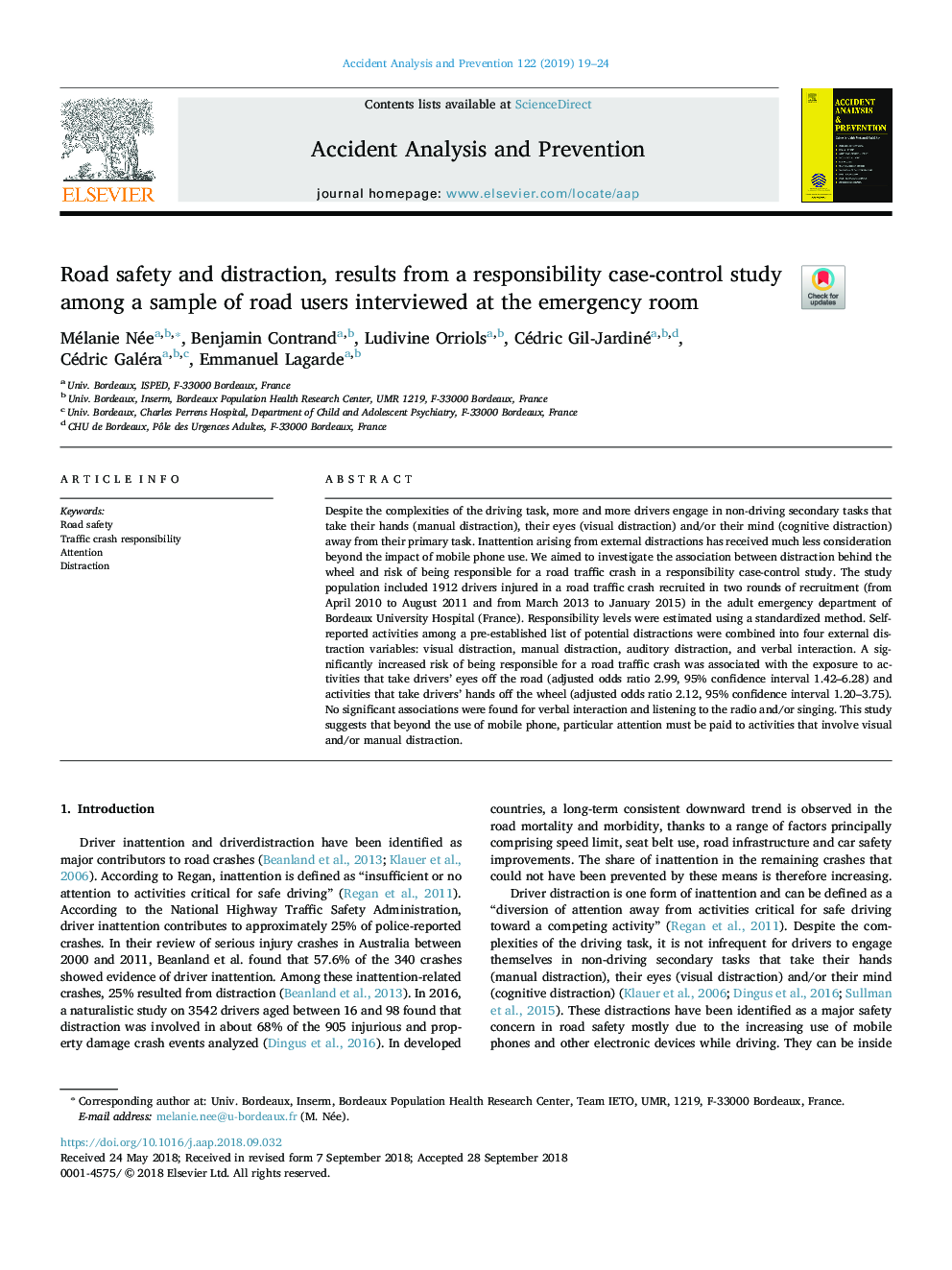| کد مقاله | کد نشریه | سال انتشار | مقاله انگلیسی | نسخه تمام متن |
|---|---|---|---|---|
| 11012364 | 1800586 | 2019 | 6 صفحه PDF | دانلود رایگان |
عنوان انگلیسی مقاله ISI
Road safety and distraction, results from a responsibility case-control study among a sample of road users interviewed at the emergency room
ترجمه فارسی عنوان
ایمنی جاده و حواس پرتی، از یک مطالعه موردی کنترل مسئولیت در میان یک نمونه از کاربران جاده مصاحبه شده در اتاق اورژانس است
دانلود مقاله + سفارش ترجمه
دانلود مقاله ISI انگلیسی
رایگان برای ایرانیان
کلمات کلیدی
ایمنی جاده، مسئولیت سقوط ترافیک، توجه حواس پرتی،
ترجمه چکیده
علیرغم پیچیدگی های کار رانندگی، رانندگان بیشتر و بیشتر درگیر کارهای ثانویه غیر رانندگی می شوند که دستشان را از دست می دهند (چشم پوشی از تمرکز حواس)، چشمانشان (غفلت بصری) و / یا ذهنشان (حواس پرتی شناختی) دور از کار اصلیشان است. نادیده گرفتن ناشی از حواس پرتی های خارجی، فراتر از تأثیر استفاده از تلفن های همراه است. هدف ما بررسی ارتباط بین حواس پرتی پشت چرخ و خطر داشتن مسئولیت سقوط ترافیک جاده در یک مطالعه موردی کنترل مسئولیت بود. در این تحقیق، 1912 راننده مجروح در یک تصادف جاده ای که در دو دوره استخدام (از آوریل 2010 تا اوت 2011 و از مارس 2013 تا ژانویه 2015) در بخش اورژانس بزرگسال بیمارستان دانشگاه بوردو (فرانسه) استخدام شده بودند، استخدام شدند. سطوح مسئولیت با استفاده از یک روش استاندارد برآورد شد. فعالیت های خود گزارش شده در میان یک لیست از پیش تعریف شده از حواس پرتی بالقوه به چهار متغیر حواسپرتی خارجی تقسیم شده است: انحراف بصری، منحرف کردن دستی، اختلال شنوایی و تعامل کلامی. یک خطر قابل توجه افزایش مسئولیت تصادف در جاده ها با قرار گرفتن در معرض فعالیت هایی است که چشم های راننده را از جاده (نسبت شانس 2.99، 95٪ اطمینان 1.42-6.28) و فعالیت هایی که رانندگان را از دست می دهند چرخ (نسبت شانس 2.12، فاصله اطمینان 95٪ 1.20-3.75). ارتباطات معنادار برای تعامل کلامی و گوش دادن به رادیو و / یا آواز یافت نشد. این مطالعه نشان می دهد که فراتر از استفاده از تلفن همراه، باید توجه ویژه ای به فعالیت هایی که شامل اختلال بصری و یا دستی باشد، پرداخت شود.
موضوعات مرتبط
مهندسی و علوم پایه
مهندسی شیمی
بهداشت و امنیت شیمی
چکیده انگلیسی
Despite the complexities of the driving task, more and more drivers engage in non-driving secondary tasks that take their hands (manual distraction), their eyes (visual distraction) and/or their mind (cognitive distraction) away from their primary task. Inattention arising from external distractions has received much less consideration beyond the impact of mobile phone use. We aimed to investigate the association between distraction behind the wheel and risk of being responsible for a road traffic crash in a responsibility case-control study. The study population included 1912 drivers injured in a road traffic crash recruited in two rounds of recruitment (from April 2010 to August 2011 and from March 2013 to January 2015) in the adult emergency department of Bordeaux University Hospital (France). Responsibility levels were estimated using a standardized method. Self-reported activities among a pre-established list of potential distractions were combined into four external distraction variables: visual distraction, manual distraction, auditory distraction, and verbal interaction. A significantly increased risk of being responsible for a road traffic crash was associated with the exposure to activities that take drivers' eyes off the road (adjusted odds ratio 2.99, 95% confidence interval 1.42-6.28) and activities that take drivers' hands off the wheel (adjusted odds ratio 2.12, 95% confidence interval 1.20-3.75). No significant associations were found for verbal interaction and listening to the radio and/or singing. This study suggests that beyond the use of mobile phone, particular attention must be paid to activities that involve visual and/or manual distraction.
ناشر
Database: Elsevier - ScienceDirect (ساینس دایرکت)
Journal: Accident Analysis & Prevention - Volume 122, January 2019, Pages 19-24
Journal: Accident Analysis & Prevention - Volume 122, January 2019, Pages 19-24
نویسندگان
Mélanie Née, Benjamin Contrand, Ludivine Orriols, Cédric Gil-Jardiné, Cédric Galéra, Emmanuel Lagarde,
